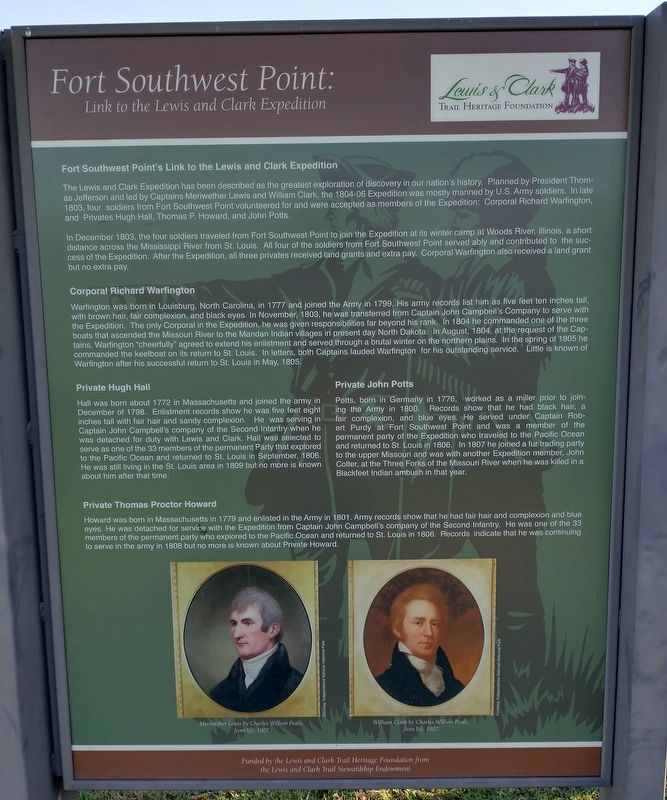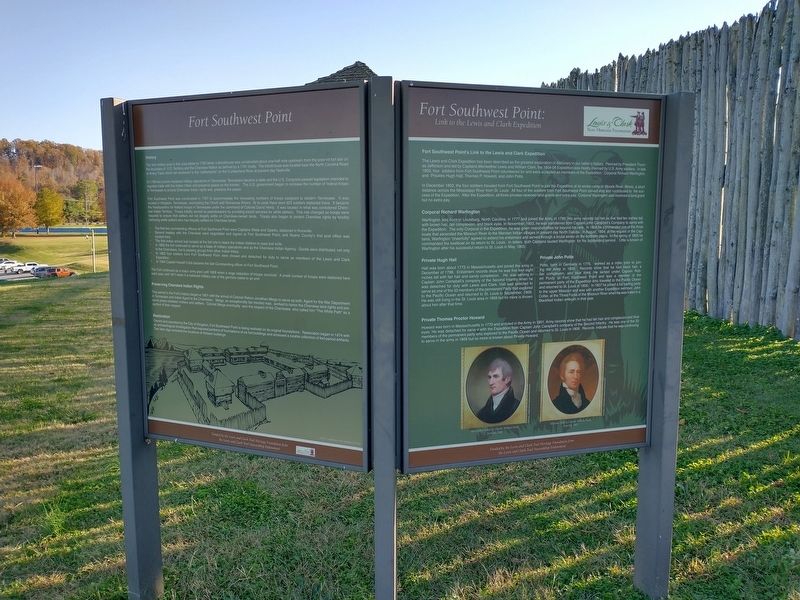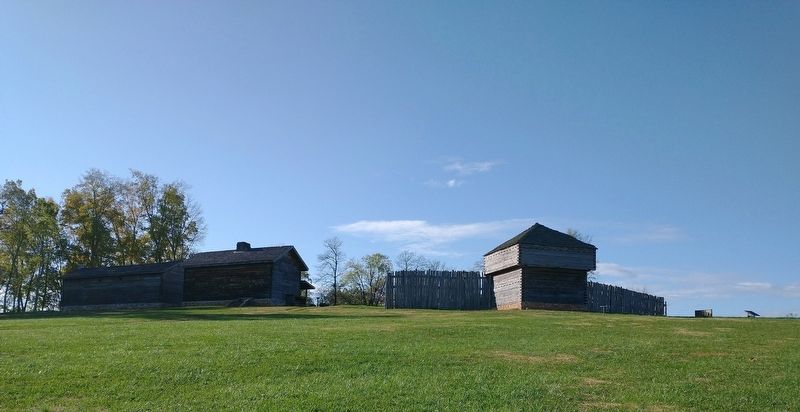Kingston in Roane County, Tennessee — The American South (East South Central)
Fort Southwest Point
Link to the Lewis and Clark Expedition
Fort Southwest Point’s link to the Lewis and Clark Expedition
The Lewis and Clark Expedition has been described as the greatest exploration of discovery in our nation’s history. Planned by President Thomas Jefferson and led by Captains Meriwether Lewis and William Clark, the 1804-06 Expedition was mostly manned by U.S. Army soldiers. In late 1803, four soldiers from Fort Southwest Point volunteered for and were accepted as members of the Expedition: Corporal Richard Warfington, and Privates Hugh Hall, Thomas P. Howard and John Potts.
In December 1803, the four soldiers traveled from Fort Southwest Point to join the Expedition at its winter camp at Woods River, Illinois, a short distance across the Mississippi River from St. Louis. All four of the soldiers from Fort Southwest Point served ably and contributed to the success of the Expedition. After the Expedition, all three privates received land grants and extra pay. Corporal Warfington also received a land grant but no extra pay.
Corporal Richard Warfington
Warfington was born in Louisburg, North Carolina, in 1777 and joined the army in 1799. His army records list him as five feet ten inches tall, with brown hair, fair complexion, and black eyes. In November, 1803, he was transferred from Captain John Campbell’s Company to serve with the Expedition. The only Corporal in the Expedition, he was given responsibilities far beyond his rank. In 1804 he commanded one of the three boats that ascended the Missouri River to the Mandan Indian villages in present day North Dakota. In August, 1804, at the request of the Captains, Warfington “cheerfully” agreed to extend hiss enlistment and served through a brutal winter on the northern plains. In the spring of 1805 he commanded the keelboat on its return to St. Louis. In letters, both Captains lauded Warfington for his outstanding service. Little is known of Warfington after his successful return to St. Louis in May, 1805.
Private Hugh Hall
Hall was born about 1772 in Massachusetts and joined the army in December of 1798. Enlistment records show he was five feet eight inches tall with fair hair and sandy complexion. He was serving in Captain John Campbell’s company of the Second Infantry when he was detached for duty with Lewis and Clark. Hall was selected to serve as one of the 33 members of the permanent Party that explored to the Pacific Ocean and returned to St. Louis in September, 1806. He was still living in the St. Luis area in 1809 but no more is known about him after that time.
Private John Potts.
Potts, born in Germany in 1776, worked as a miller prior to joining the Army in 1800. Records show that he had black hair, a fair complexion, and blue eyes. He served under Captain Robert Purdy at Fort Southwest Point and was a member of the permanent party of the Expedition who traveled to the Pacific Ocean and returned to St. Louis in 1806. In 1807 he joined a fur trading party to the upper Missouri and was with another Expedition member, John Colter, at the Three Forks of the Missouri River when he was killed in a Blackfeet Indian ambush in that year.
Private Thomas Proctor Howard
Howard was born in Massachusetts in 1779 and enlisted in the Army in 1801. Army records show that he had fair hair and complexion and blue eyes. He was detached for service with the Expedition from Captain John Campbell’s company of the Second Infantry. He was one of the 33 members of the permanent party who explored to the Pacific Ocean and returned to St. Louis in 1806. Records indicate that he was continuing to serve in the army in 1808 but no more is known about Private Howard.
Erected by Lewis and Clark Trail Heritage Foundation from the Lewis and Clark Trail Stewardship Endowment.
Topics and series. This historical marker is listed in these topic lists: Exploration • Forts and Castles. In addition, it is included in the Lewis & Clark Expedition series list. A significant historical month for this entry is May 1805.
Location. 35° 51.662′ N, 84° 31.728′ W. Marker is in Kingston, Tennessee, in Roane County. Marker can be reached from South Kentucky Street (Tennessee Route 58) 0.1 miles north of Shannon Place, on the left when traveling north. Touch for map. Marker is at or near this postal address: 1226 S Kentucky St, Kingston TN 37763, United States of America. Touch for directions.
Other nearby markers. At least 8 other markers are within walking distance of this marker. A different marker also named Fort Southwest Point (here, next to this marker); Fort Privy 12 (a few steps from this marker); Soldier’s Barracks #5 (a few steps from this marker); Blockhouse #12 (a few steps from this marker); The First Federal Fort in Tennessee (within shouting distance of this marker); Blockhouse #10 (within shouting distance of this marker); Carpenter and Tack Building #7 (within shouting distance of this marker); Soldier’s Barracks w/ Cellar #4 (within shouting distance of this marker). Touch for a list and map of all markers in Kingston.
Credits. This page was last revised on November 13, 2020. It was originally submitted on November 11, 2020, by Tom Bosse of Jefferson City, Tennessee. This page has been viewed 174 times since then and 17 times this year. Photos: 1, 2, 3, 4. submitted on November 11, 2020, by Tom Bosse of Jefferson City, Tennessee. • Devry Becker Jones was the editor who published this page.



